In-situ Swelling Testing System for Model Coin Cell MCS1000
Lithium-ion battery, as a popular energy storage carrier, has been widely used in life. With the increase of application scenarios, the battery safety also has higher requirements. In the process of lithium-ion battery charge and discharge, it will be accompanied by different degrees of swelling. On the one hand, it will affect the deformation of the battery assembly space, on the other hand, the irreversible swelling accumulation will also cause the structural destruction of the active material, thus accelerating the capacity attenuation. In the monomer cell layer, the characterization of cell swelling has more characterization methods.Such as by applying a certain pressure on the cell surface to test the thickness of the cell. The swelling force, the swelling D of the cell, including multiple layers of positive and negative pole sheet, diaphragm, aluminum plastic film or aluminum shell, cannot accurately locate the source of swelling and quantification of a material.
So for lithium researchers still have certain limitations. Coin battery is a kind of battery used by lithium researchers, it is composed of a single layer of positive and negative electrode and diaphragm, but due to the binding of the positive and negative electrode steel shell, the electrode of the swelling cannot be measured. If the influence of positive and negative electrode steel shell is excluded and the model coin battery is used to explore the swelling behavior of single layer battery, it can more directly analyze the swelling performance of active material, which is helpful to evaluate the feasibility of material modification and process formula optimization.
Scheme of Model Coin Cell
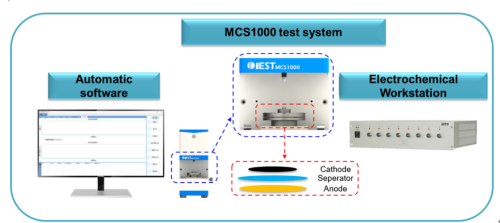
1. Automated testing software
2. Model buckle cell in-situ swelling test System
3. Charge and discharge equipment/ electrochemical workstation
Main Features
1.The instrument size is small (length*width*height 120*150*280mm), which can be placed in the glove box.
2.The fixture of the model coin cell can used to assemble various types of full battery.
3.Good sealing, to ensure long-term test stability and to obtain more reliable test results.
4.High-precision thickness measurement system, thickness measurement resolution 0.1µm, precision±1 µm.
5.In-situ test of the full-cell swelling thickness curve.
6.Solid electrolyte ion conductivity can be tested.
7.The software automatically combines the model battery thickness change data and charging and discharge data (compatible with partial charging and discharge instrument), and outputs the test data report.
Application Case
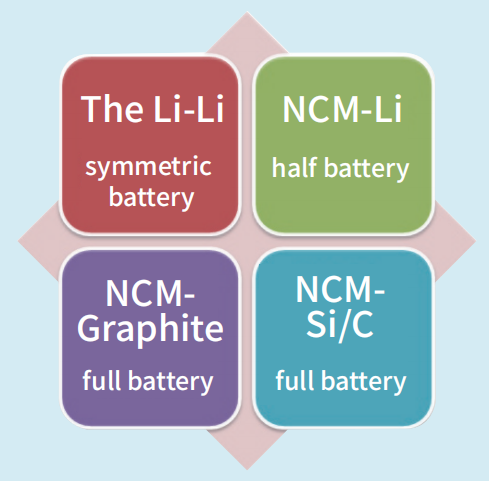
1.The L i-L i Symmetric Battery
Assemble Li-Li symmetrical battery to test the thickness change during lithium deposition; test parameters: current density is 0.5mA / cm2, charged and discharging for 2h and rest for 5min. During lithium plating, the total thickness of the battery gradually increased, and per 2mAh of lithium plating, the total battery thickness increased by 2 μm, corresponding to a volume swelling of about 0.76mm3/mAh.

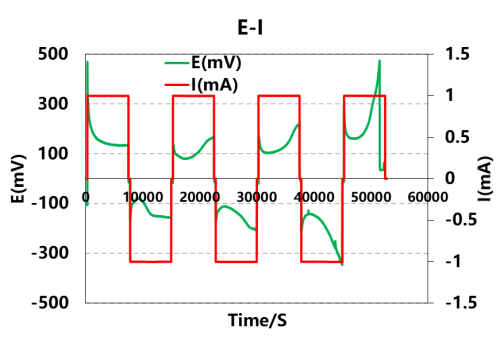 | 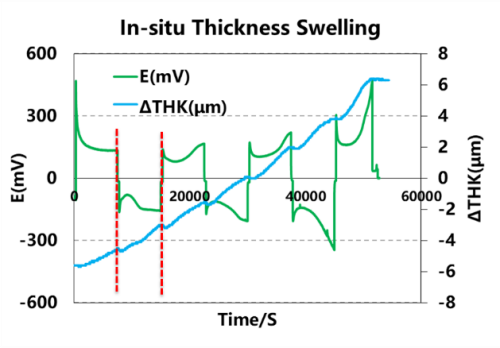 |
2.NCM-Li Half Battery
Assemble the NCM-Li battery to test the thickness change during charge and discharge; test parameters: the current density is 0.6mA / cm2,3~4.3V. During the charging process, the battery thickness swelling is about 4 μm / mAh, and the volume swelling is about (0.6mm3 / mAh), mainly caused by the deposition of lithium in NCM surface of the lithium sheet. During discharge, the thickness shrinkage is about 3 μm / mAh, and the volume shrinkage is about (0.5mm3/mAh), mainly due to the continuous removal of lithium from the lithium sheet embedded ternary, the thickness of the lithium sheet decreases;
 |
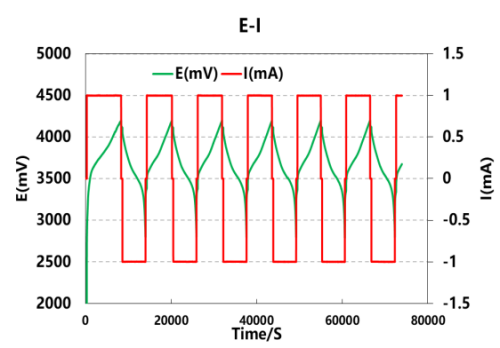 | 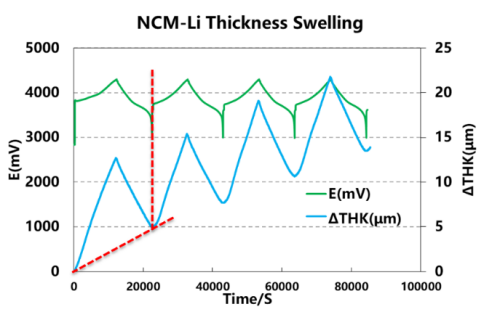 |
3.NCM-Graphite Full Battery
Assemble the NCM-Graphite battery to test the thickness change during charge and discharge; test parameters: the current density is 0.6mA / cm2,2.8~4.2V. The thickness of the battery decreases in the first circle of charging, mainly due to the rest stage after assembly, under a certain pressure condition, the interface contact between the positive and negative electrodes will gradually close, so it is necessary to start the charging time as far as possible for more than 3h before testing the thickness swelling. During the late charge and discharge process, the thickness change of both charging and discharge was about 1.33 μm / mAh, with a corresponding volume change of 0.2mm3/ mAh, which is mainly caused by lithium removal of graphite; the thickness of graphite coating is about 100μm. If the swelling of positive electrode is ignored, the percentage of thickness expansion of graphite is 2%.
![]()

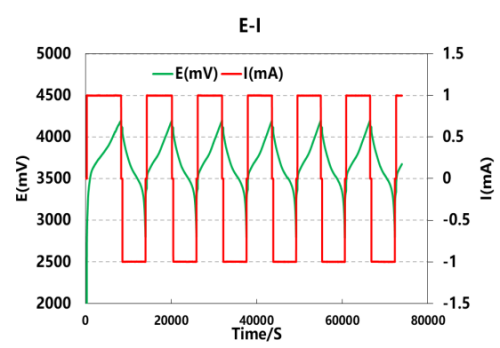 | 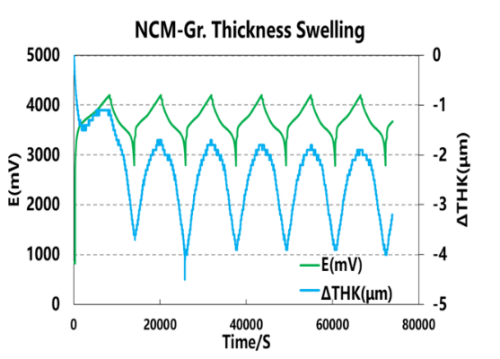 |
4.NCM-Si/C Full Battery
Assemble NCM-Si / C battery and test the thickness change during charge and discharge; test parameters: current density is 0.6mA / cm2,3~4.3V. When the thickness of the test model battery expands, the swelling of the positive NCM plate is ignored, the total swelling is mainly the swelling of the negative SiC, and then deducting the thickness of copper foil, the swelling percentage can be calculated. Compared with two kinds of materials, swelling of A material is greater than B, and the first circle full, the difference is smaller, and subsequent cycle, B maximum swelling thickness will decrease compared to the first circle, the subsequent slow increase, for A material, each circle of the maximum swelling thickness has been increasing, this is related to the two material modification way.

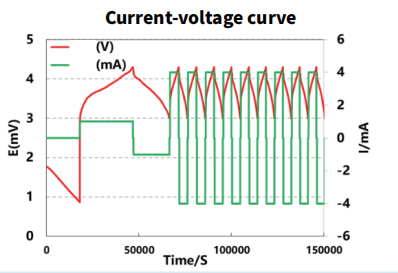 | 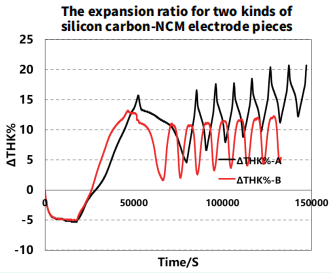 |
Main Instrument Parameters
Scope of Thickness Measurement | 0~10mm |
Thickness Resolution | 0.1μm |
Thickness Measurement Accuracy | ±1μm |
Mold Size | Inner diameter 13mm, 16mm, 20mm (other diameters available) |
Installation Conditions
Source | 220~240V /50~60H z |
Voltage Change Tolerance |
|
Power Consumption | 30W |
Ambient Temperature | 10℃~50℃ |
Relative Humidity | 0~80%RH (no condensation) |
Net Weight | 10Kg |
Size | 120*150*280mm |
